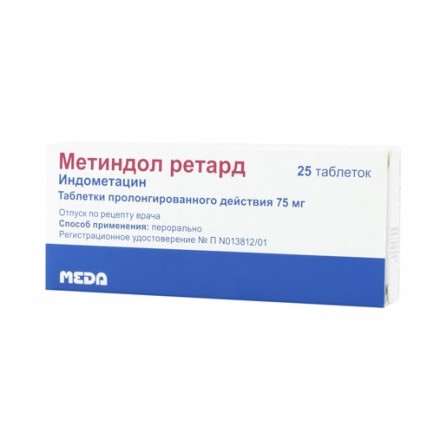Metindol retard pills 25 pcs
Condition: New product
1000 Items
Rating:
Be the first to write a review!

More info
Active ingredients
Indomethacin
Release form
Pills
Composition
Indomethacin. Excipients: microcrystalline cellulose - 48.6 mg, potato starch - 16.2 mg, methacrylic acid copolymer - 5.4 mg, talc - 1.8 mg, magnesium stearate - 3 mg.
Pharmacological effect
Anti-inflammatory, antipyretic, analgesic, desensitizing. Blocks cyclooxygenase in the arachidonic acid cascade, inhibits PG biosynthesis
Pharmacokinetics
Absorption is fast. The bioavailability of the appointment inside the usual pills, pills or capsules - 90-98%, when using pills of prolonged action within 12 hours, 90% of the administered dose is absorbed. After ingestion, TCmax - 2 h, Cmax - 0.69 mcg / ml. Communication with plasma proteins - 90%. Metabolized mainly in the liver. T1 / 2 - 4-9 h (the indicator may vary depending on the severity of systemic metabolism, enterohepatic circulation and reabsorption). Excreted by the kidneys by 70%, with 30% unchanged, and the gastrointestinal tract - 30%. Penetrates into breast milk, when mother uses 200 mg of the drug per day in milk is determined from 0.5 to 2 mg. The drug is not removed during dialysis
Indications
Rheumatoid arthritis, ankylosing spondylitis, osteoarthritis, tendonitis, synovitis, acute gouty arthritis, reactive arthritis
Contraindications
Hypersensitivity, rhinitis, conjunctivitis or bronchospasm while taking NSAIDs, erosive and ulcerative lesions of the gastrointestinal tract, bleeding (especially intracranial or from the gastrointestinal tract), thrombocytopenia, hypocoagulation, suspected necrotizing enterocolitis, severe renal insufficiency, congenital heart disease, a rash heart (tethered mouse), a racer, a rash heart, a rash heart, a tetanus, a rash heart, a tetanus, a hysterocarditis, necrosis, necrosis, necrotizing enterocolitis, severe renal failure. ), proctitis (suppositories), pregnancy (teratogenicity may occur)
Precautionary measures
Precautions should be used drug for ischemic heart disease, cerebrovascular diseases, disorders of hematopoiesis (leucopenia and anemia), congestive heart failure, dyslipidaemia / hyperlipidemia, thrombocytopenia, diabetes, diseases of the peripheral arteries, arterial hypertension, smoking, cirrhosis with portal hypertension, QC less than 60 ml / min immediately after surgery; in the presence of amnestic data on the development of ulcerative lesions of the gastrointestinal tract,in the presence of Helicobacter pylori infection, in old age, with long-term use of NSAIDs, frequent use of alcohol, severe somatic diseases, concomitant therapy with the following drugs: anticoagulants (for example, warfarin), antiplatelet agents (for example, acetylsalicylic acid, clopidogrel), oral glucocorticoidoids, antigreganty (for example, acetylsalicylic acid, clopidogrel), oral glucocorticoid steroids, anti-gagroanty agents (for example, acetylsalicylic acid, clopidogrel), oral glucocorticoid steroids, anti-aggregants (for example, acetylsalicylic acid, clopidogrel), oral glucocorticoid drugs (for example, acetylsalicylic acid, clopidogrel), oral glucocorticoid steroids, antiplatelet agents (for example, acetylsalicylic acid, clopidogrel), oral glucocorticoid steroids, antiplatelet agents (e.g. prednisolone), selective serotonin reuptake inhibitors (for example, citalopram, fluoxetine, paroxetine, sertraline). Also, be careful when prescribing Metindol retard and for patients suffering from mental disorders, depression, parkinsonism, epilepsy. To reduce the risk of adverse events, use the minimum effective dose with the shortest possible short course.
Use during pregnancy and lactation
Metindol Retard is contraindicated in pregnancy and lactation. Penetrates into breast milk, when mother uses 200 mg of the drug per day, 0.5 to 2 mg is determined in milk.
Dosage and administration
Inside, after eating. Adults are prescribed in an initial dose of 25 mg 2-3 times a day, with insufficient effect, 50 mg 3 times a day, retard pills (75 mg) 1-2 times a day, the maximum daily dose is 200 mg, with long-term use - should not exceed 75 mg. When effect is achieved, treatment is continued for 4 weeks. in the same or reduced dose. For the treatment of acute conditions or the relief of an exacerbation of a chronic process, 60 mg 1–2 times a day for 7–14 days are injected into the / m, after which they are transferred to pills or suppositories (0.05 or 0.1 g 2 times a day).
Side effects
Nausea, vomiting, epigastric pain, erosive and ulcerative lesions of the gastrointestinal tract, gastrointestinal bleeding, rectal bleeding, chronic hepatitis, constipation, hypertension, heart rhythm disorders, bone marrow hypoplasia, aplastic anemia, autoimmune hemolytic anemia, agranulocytosis, thrombocytopenia, impaired platelet function, fluid retention, hyperglycemia, glycosuria, hyperkalemia, pruritus, urticaria, exfoliative dermatitis, hair loss, erythema nodule, Stevens-Johnson syndrome, anaphilac tic shock, bronchospasm, vasculitis, pulmonary edema
Overdose
The clinical picture of Metindol Retard overdose is characteristic of indomethacin and includes the following symptoms: nausea, vomiting, severe headache, dizziness, memory impairment and disorientation. In more severe cases, paresthesias, numbness of the extremities and convulsions are observed. Treatment: Treatment consists in the rapid elimination of the drug from the body and the use of appropriate symptomatic agents. Indomethacin cannot be eliminated through hemodialysis.
Interaction with other drugs
Reduces the diuretic effect of potassium-sparing, thiazide and loop diuretics, hypotension caused by beta-blockers. Increases (mutually) the risk of side effects (first of all, gastrointestinal lesions) of other NSAIDs. Enhances the toxicity of methotrexate (reduces its tubular secretion). Causes an increase in plasma levels of lithium, digoxin
special instructions
When combined with cyclosporine, it is necessary to monitor renal function.




